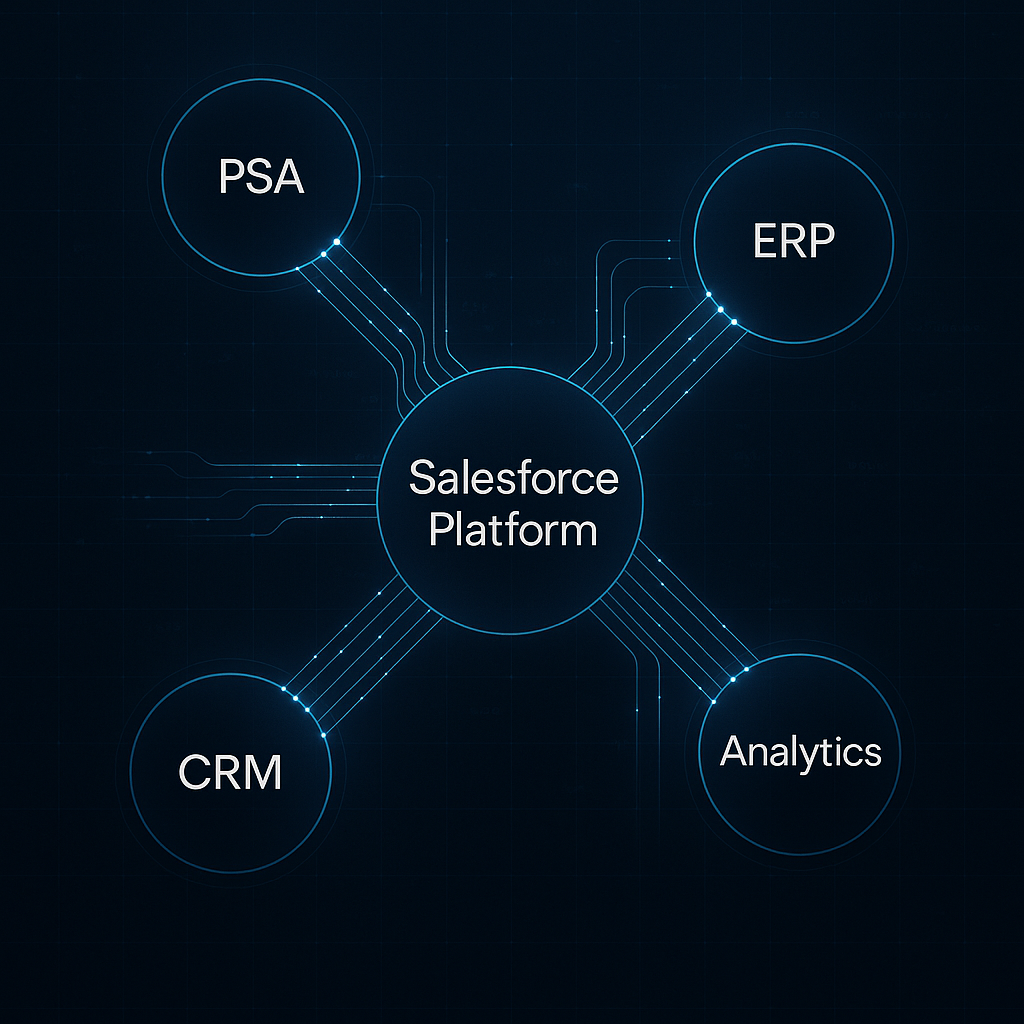
Table of Contents
Professional services organizations face a critical systems challenge: existing ERP solutions rarely align with the project-driven nature of services delivery. Certinia addresses this fundamental mismatch through an architecture built specifically for the services lifecycle. Formerly known as FinancialForce, Certinia represents a different way of thinking about enterprise software, one that is built with the services lifecycle at its core. Longitudinal data and field-tested perspectives highlight that its most defining characteristic isn’t just its feature set, but its architectural foundation.
Certinia is built natively on the Salesforce platform. This isn’t just a technical detail; it’s the entire strategic value proposition. By sharing the same data model as the world’s leading CRM, it eliminates the chasm between sales and delivery from the ground up. The opportunity in Salesforce becomes the project in Certinia without any clunky integration or data re-entry. It creates a single source of truth that extends from the first client contact to the final invoice and revenue recognition.
Core Components of a Services ERP
What makes a platform like Certinia a “Services ERP”? It’s the combination of capabilities that manage the entire bid-to-bill process.
- Professional Services Automation (PSA): This is the engine of the services lifecycle. It includes robust project management, resource management to forecast and allocate talent, and time and expense tracking. It provides the real-time visibility into project health and profitability that is so often missing.
- Services CPQ (Configure, Price, Quote): Traditional CPQ tools are built for physical products with SKUs. Services CPQ is different. It allows for the creation of complex quotes based on roles, rates, and effort, which can then be used to automatically staff projects once the deal is won.
Having these capabilities on the same platform as the company’s financial and accounting system is a game-changer. When a consultant submits a timesheet, it doesn’t just update the project plan; it’s immediately available for invoicing and can trigger the correct revenue recognition events. This tight coupling provides an unprecedented level of real-time financial control and forecasting accuracy.
Competitive Positioning in the PSA Market
Certinia occupies a unique position in the professional services automation landscape. Unlike standalone PSA solutions that require extensive integration work, or traditional ERP systems that bolt on services capabilities as an afterthought, Certinia represents a third path: purpose-built services operations on a proven enterprise platform.
This positioning becomes particularly valuable when compared to alternatives. Traditional PSA leaders like Deltek or Kimble require significant integration investment to connect with CRM and financial systems. Enterprise ERP solutions like NetSuite or Microsoft Dynamics offer services modules, but these often feel like add-ons rather than core competencies. Certinia’s native Salesforce foundation eliminates these integration challenges while providing enterprise-grade scalability and security.
The platform’s strength becomes especially apparent in complex services organizations where project delivery spans multiple business units or geographic regions. The shared data model ensures consistent reporting and resource visibility across the entire organization, something that’s notoriously difficult to achieve with federated systems.
Implementation and Adoption Considerations
However, Certinia’s architectural advantages come with specific implementation requirements that organizations must carefully consider. Success depends heavily on standardizing business processes around the platform’s opinionated workflows rather than extensive customization to match existing practices.
The most successful implementations I’ve observed follow a disciplined approach to process standardization. Organizations that try to replicate every nuance of their existing workflows often struggle with complexity and maintenance challenges. Those that embrace Certinia’s standard processes while focusing customization on truly differentiating capabilities achieve faster deployment and better long-term outcomes.
Change management becomes particularly critical given the platform’s integrated nature. When sales, delivery, and finance teams all work within the same system, traditional departmental boundaries become more fluid. This can create significant organizational benefits but requires thoughtful planning to manage the cultural transition.
Training and user adoption also require special attention. Unlike implementations where different teams can be trained on their specific modules in isolation, Certinia’s integrated approach means users need to understand how their actions impact downstream processes. This holistic perspective ultimately creates better business outcomes but demands more comprehensive training programs.
Strategic Value Proposition and Future Outlook
Of course, no system is a silver bullet. The success of a platform like Certinia hinges on a clear understanding of your business processes and a commitment to adopting a more unified operational model. But for organizations struggling with a patchwork of disconnected systems, it presents a compelling architectural vision. Tomorrow, we’ll explore the practicalities of plugging a system like this into the broader enterprise landscape.
Connect with me on LinkedIn.